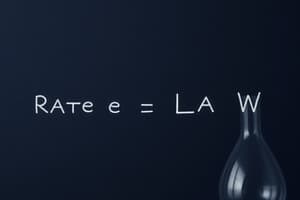Podcast
Questions and Answers
पहले क्रम की प्रतिक्रिया में आधी आयु किसकी माप है?
पहले क्रम की प्रतिक्रिया में आधी आयु किसकी माप है?
- उत्पाद की सांद्रता
- प्रारंभिक सांद्रता की आधा मान (correct)
- प्रतिक्रिया की दर
- प्रतिक्रिया की अवधि
दर नियम क्या है?
दर नियम क्या है?
- प्रारंभिक सांद्रता का मात्रात्मक व्यक्त
- प्रतिक्रिया की दर का मात्रात्मक व्यक्त (correct)
- उत्पाद की सांद्रता का मात्रात्मक व्यक्त
- प्रतिक्रिया की अवधि का मात्रात्मक व्यक्त
दर स्थिरांक का मात्रक क्या है?
दर स्थिरांक का मात्रक क्या है?
- एम^(-1)से(-1)
- एम से(-1)
- से(-1) (correct)
- एम^2 से(-1)
कौन सी प्रतिक्रिया पहले क्रम की प्रतिक्रिया लगती है, लेकिन वास्तव में उच्च क्रम की प्रतिक्रिया है?
कौन सी प्रतिक्रिया पहले क्रम की प्रतिक्रिया लगती है, लेकिन वास्तव में उच्च क्रम की प्रतिक्रिया है?
प्रतिक्रिया की दर किसके सीधे आनुपातिक है?
प्रतिक्रिया की दर किसके सीधे आनुपातिक है?
दर स्थिरांक किस पर निर्भर करता है?
दर स्थिरांक किस पर निर्भर करता है?
आधी आयु किसके साथ संबंधित है?
आधी आयु किसके साथ संबंधित है?
प्रतिक्रिया की दर की गणना किसके द्वारा की जा सकती है?
प्रतिक्रिया की दर की गणना किसके द्वारा की जा सकती है?
Flashcards are hidden until you start studying
Study Notes
First-Order Reaction
Half-Life
- The time required for the concentration of the reactant to decrease to half of its initial value.
- Denoted by t1/2.
- Constant for a given reaction, independent of initial concentration.
- Related to the rate constant (k) by the equation: t1/2 = ln(2) / k
- Half-life is a measure of the reaction's rate, with shorter half-lives indicating faster reactions.
Rate Law
- A mathematical expression that describes the rate of a reaction.
- For a first-order reaction, the rate law is: rate = k[A]
- Where k is the rate constant, and [A] is the concentration of the reactant.
- The rate of the reaction is directly proportional to the concentration of the reactant.
Rate Constant
- A measure of the reaction's rate, independent of concentration.
- Denoted by k.
- Units: s^(-1) or M^(-1)s^(-1)
- The rate constant is a constant for a given reaction, and is dependent on temperature and other reaction conditions.
Pseudo-First-Order
- A reaction that appears to be first-order, but is actually a higher-order reaction.
- Occurs when the concentration of one reactant is much higher than the other reactant(s).
- The excess reactant is essentially constant, making the reaction appear first-order.
- Pseudo-first-order reactions can be treated as first-order reactions for simplicity, but may not accurately represent the underlying reaction mechanism.
प्रथम-क्रम प्रतिक्रिया
आधा जीवन
- प्रारंभिक मान से आधे तक रिएक्टेंट की सांद्रता घटाने में लगने वाला समय।
- t1/2 द्वारा संकेतित।
- एक निश्चित प्रतिक्रिया के लिए स्थिर, प्रारंभिक सांद्रता से स्वतंत्र।
- दर स्थिरांक (k) के साथ संबंधित: t1/2 = ln(2) / k
- आधा जीवन प्रतिक्रिया की दर के लिए एक माप है, जिसका अर्थ है कि अल्प जीवन अवधि वाली प्रतिक्रियाएं तेज होती हैं।
दर विधि
- प्रतिक्रिया की दर का गणितीय выражा ।
- प्रथम-क्रम प्रतिक्रिया के लिए दर विधि: दर = k[A]
- जहाँ k दर स्थिरांक है, और [A] रिएक्टेंट की सांद्रता है।
- प्रतिक्रिया की दर रिएक्टेंट की सांद्रता के přímo आनुपातिक है।
दर स्थिरांक
- प्रतिक्रिया की दर का एक माप, सांद्रता से स्वतंत्र।
- k द्वारा संकेतित।
- единица: s^(-1) or M^(-1)s^(-1)
- दर स्थिरांक एक निश्चित प्रतिक्रिया के लिए स्थिर है, और तापमान और अन्य प्रतिक्रिया स्थितियों पर निर्भर है।
आभासी प्रथम-क्रम
- एक प्रतिक्रिया जो प्रथम-क्रम जैसी लगती है, लेकिन वास्तव में उच्च-क्रम प्रतिक्रिया है।
- दूसरे रिएक्टेंट(s) की तुलना में एक रिएक्टेंट की सांद्रता बहुत अधिक होने पर घटित होता है।
- अतिरिक्त रिएक्टेंट में लगभग स्थिर है, जिससे प्रतिक्रिया प्रथम-क्रम जैसी लगती है।
- आभासी प्रथम-क्रम प्रतिक्रियाओं को सादगी के लिए प्रथम-क्रम प्रतिक्रिया के रूप में माना जा सकता है, लेकिन यह अंतर्निहित प्रतिक्रिया तंत्र का सटीक प्रतिनिधित्व नहीं कर सकता है।
Studying That Suits You
Use AI to generate personalized quizzes and flashcards to suit your learning preferences.




